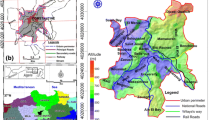Abstract
Landslide susceptibility zonation (LSZ) is necessary for disaster management and planning development activities in mountainous regions. A number of methods, viz. landslide distribution, qualitative, statistical and distribution-free analyses have been used for the LSZ studies and they are again briefly reviewed here. In this work, two methods, the Information Value (InfoVal) and the Landslide Nominal Susceptibility Factor (LNSF) methods that are based on bivariate statistical analysis have been applied for LSZ mapping in a part of the Himalayas. Relevant thematic maps representing various factors (e.g., slope, aspect, relative relief, lithology, buffer zones along thrusts, faults and lineaments, drainage density and landcover) that are related to landslide activity, have been generated using remote sensing and GIS techniques. The LSZ derived from the LNSF method, has been compared with that produced from the InfoVal method and the result shows a more realistic LSZ map from the LNSF method which appears to conform to the heterogeneity of the terrain.







Similar content being viewed by others
References
Aleotti P, Chowdhury R (1999) Landslide hazard assessment: summary review and new perspectives. Bull Eng Geol Environ 58:21–44
Anbalagan R (1992) Landslide hazard evaluation and zonation mapping in mountainous terrain. Eng Geol 32:269–277
Arora MK, Das Gupta AS, Gupta RP (2004) An artificial neural network approach for landslide hazard zonation in the Bhagirathi (Ganga) Valley, Himalayas. Int J Remote Sens 25:559–572
Ayalew L, Yamagishi H, Ugawa N (2004) Landslide susceptibility mapping using GIS-based weighted linear combination, the case in Tsugawa area of Agano River, Niigata Prefecture, Japan. Landslides 1:73–81
Bughi S, Aleotti P, Bruschi R, Andrei G, Milani G, Scarpelli G (1996) Slow movements of slopes interfering with pipelines: modelling vs. monitoring. In: Proc 15th Int Conf OMAE, Firenze
Capecchi F, Focardi P (1988) Rainfall and landslides: research into a critical precipitation coefficient in an area of Italy. In: Proc 5th Int Symp on Landslides, Lausanne, Switzerland 2:1131–1136
Carrara AM, Cardinali M, Detti R, Guzzetti F, Pasqui V, Reichenbach P (1991) GIS techniques and statistical models in evaluating landslide hazard. Earth Surf Process Landforms 16:427–445
Chung C-JF, Fabbri AG (1999) Probabilistic prediction models for landslide hazard mapping. Photo Eng Remote Sens 65:1389–1399
Elias PB, Bandis SC (2000) Neurofuzzy systems in landslide hazard assessment. In: Proc 4th Int Symp Spatial Accuracy Assessment in Natural Resources and Environ Sci, pp 199–202
Gupta RP (2003) Remote sensing geology. Springer, Berlin Heidelberg New York, 655 pp
Gupta RP, Joshi BC (1990) Landslide hazard zonation using the GIS approach – a case study from the Ramganga Catchment, Himalayas. Eng Geol 28:119–131
Gupta RP, Saha AK, Arora MK, Kumar A (1999) Landslide hazard zonation in a part of the Bhagirathi Valley, Garhwal Himalayas, using integrated remote sensing- GIS. Himalayan Geol 20:71–85
Lee S, Choi J, Chwae U, Chang B, (2002a) Landslide susceptibility analysis using weight of evidence. In: Proc IEEE Int Geosci Remote Sens Symp, Toronto (CD-ROM)
Lee S, Choi J, Min K (2002b) Landslide susceptibility analysis and verification using the Bayesian probability model. Environ Geol 43:120–131
Lu PF, An P (1999) A metric for spatial data layers in favorability mapping for geological events. IEEE Tran Geosci Remote Sens 37:1194–1198
Mantovani F, Soeters R, van Westen CJ (1996) Remote sensing techniques for landslide studies and hazard zonation in Europe. Geomorph 15:213–225
Nagarajan R, Mukherjee A, Roy A, Khire MV (1998) Temporal remote sensing data and GIS application in landslide hazard zonation of part of Western Ghat, India. Int J Remote Sens 19:573–585
Okimura T, Kawatani T (1986) Mapping of the potential surface-failure sites on granite mountain slopes. In: Gardiner V (ed) Int Geomorp Part I. Wiley, New York, pp 121–138
Ravindran KV, Philip G (1999) 29 March 1999 Chamoli earthquake: a preliminary report on earthquake-induced landslides using IRS-1C/1D data. Current Sc 77:21–25
Saha AK, Gupta RP, Arora MK (2002) GIS-based landslide hazard zonation in the Bhagirathi (Ganga) Valley, Himalayas. Int J Remote Sens 23:357–369
Saha AK, Arora MK, Csaplovics E, Gupta RP (2004) Land cover classification using IRS LISS III imagery and DEM in a rugged terrain: a case study in Himalaya. GeoCarto Int (revised and sent)
Sarkar S, Kanungo DP (2004) An integrated approach for landslide susceptibility mapping using remote sensing and GIS. Photo Eng Remote Sens 70:617–625
Valdiya KS (1980) Geology of Kumaun Lesser Himalaya. Wadia Inst of Himalayan Geol, Dehra Dun, 292 pp
van Westen CJ (1997) Statistical landslide hazard analysis. In: Application guide, ILWIS 2.1 for Windows. ITC, Enschede, The Netherlands, pp 73–84
van Westen CJ (1994) GIS in landslide hazard zonation: a review, with examples from the Andes of Colombia. In: Price M, Heywood I (eds) Mountain environments and geographic information system. Taylor and Francis, Basingstoke, UK, pp 135–165
Varnes DJ (1984) Landslide hazard zonation: a review of principles and practice. UNESCO, Paris, pp 1–63
Welch R, Ehlers M (1987) Merging multiresolution SPOT HRV and Landsat TM data. Photo Eng Remote Sens 53:301–303
Wieczorek GF (1984) Preparing a detailed landslide-inventory map for hazard evaluation and reduction. Bull Assoc Eng Geol 21:337–342
Yin KL, Yan TZ (1988) Statistical prediction model for slope instability of metamorphosed rocks. In: Proceedings of 5th Int Symp on Landslides, Lausanne, Switzerland 2:1269–1272
Acknowledgements
A. K. Saha is grateful to the Council of Scientific and Industrial Research (CSIR), New Delhi, India, for Senior Research Fellowship. He is also thankful to German Academic Exchange Service (DAAD), Bonn for the award of DAAD Sandwich Fellowship, during which a part of this work was carried out at the Institute of Photogrammetry and Remote Sensing, Dresden University of Technology, Germany. Thanks are due to Dr. L. Ayalew, Department of Environmental Science, Niigata University, Japan and Dr. R. Anbalagan, Department of Earth Sciences, IIT Roorkee, India, for their valuable comments.
Author information
Authors and Affiliations
Corresponding author
Rights and permissions
About this article
Cite this article
Saha, A.K., Gupta, R.P., Sarkar, I. et al. An approach for GIS-based statistical landslide susceptibility zonation—with a case study in the Himalayas. Landslides 2, 61–69 (2005). https://doi.org/10.1007/s10346-004-0039-8
Received:
Accepted:
Published:
Issue Date:
DOI: https://doi.org/10.1007/s10346-004-0039-8




